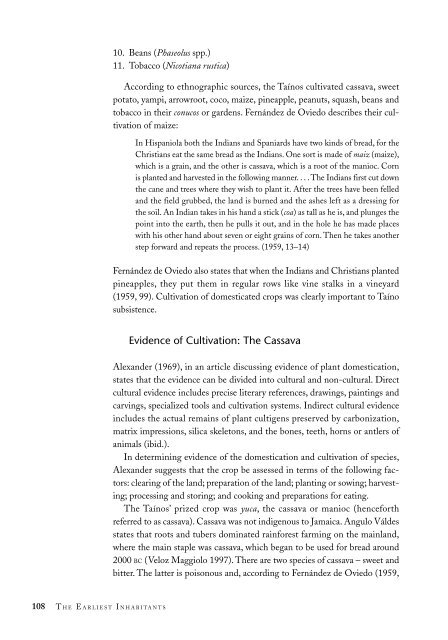The Earliest Inhabitants: The Dynamics of the Jamaican Taino
by Lesley-Gail Atkinson
by Lesley-Gail Atkinson
You also want an ePaper? Increase the reach of your titles
YUMPU automatically turns print PDFs into web optimized ePapers that Google loves.
10. Beans (Phaseolus spp.)<br />
11. Tobacco (Nicotiana rustica)<br />
According to ethnographic sources, <strong>the</strong> Taínos cultivated cassava, sweet<br />
potato, yampi, arrowroot, coco, maize, pineapple, peanuts, squash, beans and<br />
tobacco in <strong>the</strong>ir conucos or gardens. Fernández de Oviedo describes <strong>the</strong>ir cultivation<br />
<strong>of</strong> maize:<br />
In Hispaniola both <strong>the</strong> Indians and Spaniards have two kinds <strong>of</strong> bread, for <strong>the</strong><br />
Christians eat <strong>the</strong> same bread as <strong>the</strong> Indians. One sort is made <strong>of</strong> maiz (maize),<br />
which is a grain, and <strong>the</strong> o<strong>the</strong>r is cassava, which is a root <strong>of</strong> <strong>the</strong> manioc. Corn<br />
is planted and harvested in <strong>the</strong> following manner....<strong>The</strong> Indians first cut down<br />
<strong>the</strong> cane and trees where <strong>the</strong>y wish to plant it. After <strong>the</strong> trees have been felled<br />
and <strong>the</strong> field grubbed, <strong>the</strong> land is burned and <strong>the</strong> ashes left as a dressing for<br />
<strong>the</strong> soil. An Indian takes in his hand a stick (coa) as tall as he is, and plunges <strong>the</strong><br />
point into <strong>the</strong> earth, <strong>the</strong>n he pulls it out, and in <strong>the</strong> hole he has made places<br />
with his o<strong>the</strong>r hand about seven or eight grains <strong>of</strong> corn. <strong>The</strong>n he takes ano<strong>the</strong>r<br />
step forward and repeats <strong>the</strong> process. (1959, 13–14)<br />
Fernández de Oviedo also states that when <strong>the</strong> Indians and Christians planted<br />
pineapples, <strong>the</strong>y put <strong>the</strong>m in regular rows like vine stalks in a vineyard<br />
(1959, 99). Cultivation <strong>of</strong> domesticated crops was clearly important to Taíno<br />
subsistence.<br />
Evidence <strong>of</strong> Cultivation: <strong>The</strong> Cassava<br />
Alexander (1969), in an article discussing evidence <strong>of</strong> plant domestication,<br />
states that <strong>the</strong> evidence can be divided into cultural and non-cultural. Direct<br />
cultural evidence includes precise literary references, drawings, paintings and<br />
carvings, specialized tools and cultivation systems. Indirect cultural evidence<br />
includes <strong>the</strong> actual remains <strong>of</strong> plant cultigens preserved by carbonization,<br />
matrix impressions, silica skeletons, and <strong>the</strong> bones, teeth, horns or antlers <strong>of</strong><br />
animals (ibid.).<br />
In determining evidence <strong>of</strong> <strong>the</strong> domestication and cultivation <strong>of</strong> species,<br />
Alexander suggests that <strong>the</strong> crop be assessed in terms <strong>of</strong> <strong>the</strong> following factors:<br />
clearing <strong>of</strong> <strong>the</strong> land; preparation <strong>of</strong> <strong>the</strong> land; planting or sowing; harvesting;<br />
processing and storing; and cooking and preparations for eating.<br />
<strong>The</strong> Taínos’ prized crop was yuca, <strong>the</strong> cassava or manioc (henceforth<br />
referred to as cassava). Cassava was not indigenous to Jamaica. Angulo Váldes<br />
states that roots and tubers dominated rainforest farming on <strong>the</strong> mainland,<br />
where <strong>the</strong> main staple was cassava, which began to be used for bread around<br />
2000 BC (Veloz Maggiolo 1997). <strong>The</strong>re are two species <strong>of</strong> cassava – sweet and<br />
bitter. <strong>The</strong> latter is poisonous and, according to Fernández de Oviedo (1959,<br />
108 T HE E ARLIEST I NHABITANTS


















